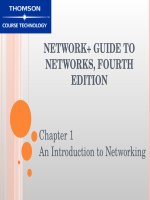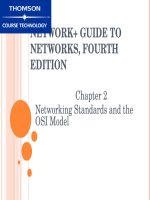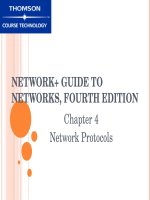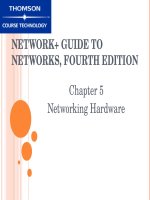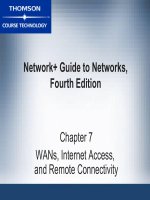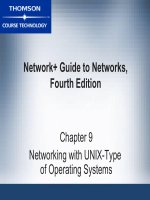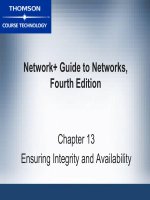Guide to network essentials 4th chapter 13
Bạn đang xem bản rút gọn của tài liệu. Xem và tải ngay bản đầy đủ của tài liệu tại đây (429.14 KB, 54 trang )
Chapter 13:
Solving Network Problems
Learning Objectives
Discuss the benefits of network management
and planning
Understand the necessity for networking
standards, policies and procedures, and
documentation
Troubleshoot your network following a structured
approach
Discuss the types of specialized equipment and
other resources available for troubleshooting
Guide to Networking Essentials, Fo
2
Preventing Problems with
Network Management and Planning
Two ways to solve networking problems
Prevent them through planning and
management
Called
pre-emptive troubleshooting or trouble
avoidance
Repair and control damage that already exists
Called
troubleshooting
Guide to Networking Essentials, Fo
3
Preventing Problems with
Network Management and Planning
(continued)
Combine network management and
troubleshooting to form overall network plan
Include
cable diagrams, cable layers, network
capacity information, protocols and network
standards, documentation on computer and network
device configuration, software, and important files
Establish network policies and procedures
Include
back-up methods, security, hardware and
software standards, upgrade guidelines, and
documentation
Guide to Networking Essentials, Fo
4
Backing Up Network Data
To prevent data loss, develop comprehensive
back-up program, including:
What
data should be backed up and how often?
What type of backup will be performed, how often,
and what time?
Who is responsible for performing backups?
Is backup system being tested regularly?
Is backup log complete?
Where is backed-up data stored (on-site and off-site)?
Table 13-1 shows several back-up methods
Guide to Networking Essentials, Fo
5
Backup Methods
Guide to Networking Essentials, Fo
6
Setting Security Policies
Security policies are part of network plan
Include
both data and hardware security
Primary data security is username and
passwords for all accounts, including:
How
often users change passwords
Whether users can reuse same passwords
What character restrictions passwords have
Whether passwords have single or multiple sets of
standards
How exceptions are defined and documented
Guide to Networking Essentials, Fo
7
Setting Security Policies (continued)
Establish guidelines for resource access
Grant
access only to users who require it
Grant minimum levels of access
Set special security requirements for dial-in accounts
Keep to a minimum the number of users who perform
network administration tasks
Guide to Networking Essentials, Fo
8
Setting Hardware and Software
Standards
Set standards for all network components
Determine supported hardware manufacturers and
operating systems, including versions
Determine what networking protocols and services will
be used
Define server configurations and guidelines for new
server installations
Evaluate standards at least once per quarter to keep
network up to date
Guide to Networking Essentials, Fo
9
Establishing Upgrade Guidelines
Establish guidelines for upgrades
Give users advance notice of changes
Try not to perform upgrades during working
hours
First “pilot” upgrades with small group of astute
network users to resolve problems
Have plan to undo upgrade installation if
necessary
Guide to Networking Essentials, Fo
10
Maintaining Documentation
Keep complete up-to-date documentation of
network, both in hard copy and in electronic
form, including:
Address list
Cable map
Contact list
Equipment list
Network history
Network map
Network hardware
configuration
Policies and procedures
Server configuration
Software configuration
Software licensing
User administration
Guide to Networking Essentials, Fo
11
Performing Pre-emptive Troubleshooting
International Organization for Standardization
(ISO) identifies five categories for pre-emptive
network troubleshooting:
Account
management
Configuration management
Fault management
Performance management
Security management
Guide to Networking Essentials, Fo
12
Practicing Good
Customer-Relation Skills
Users are customers, and the reason network
personnel have jobs
Best
source of information when something goes
wrong with network
Develop special relationships with adept users
Develop guidelines about user interaction
Include
how to question and respond to users, handle
irate users, and general user communication etiquette
Guide to Networking Essentials, Fo
13
Using Network-Monitoring Utilities
Many programs help with network management
Identify
conditions that may lead to problems, prevent
network failures, and troubleshoot problems
Use network management utilities
Learn
which statistics to monitor
Establish baseline for network performance
Monitor changes
Guide to Networking Essentials, Fo
14
Using Network-Monitoring Utilities
(continued)
Use network management utilities in advanced
operating systems or from third-party sources
Gather information about:
Events
System
usage statistics
System performance statistics
Guide to Networking Essentials, Fo
15
Using Network-Monitoring Utilities
(continued)
Use information from utilities to help:
Identify
network devices that create bottlenecks
Provide information to forecast growth and plan
capacity requirements
Develop plans to improve network performance
Monitor events that arise from software or hardware
changes
Monitor trends in network traffic and utilization
Figure 13-1 shows Windows XP Performance
Monitor
Guide to Networking Essentials, Fo
16
Windows XP Performance Monitor
Guide to Networking Essentials, Fo
17
Creating a Network Baseline
Defines point of reference for measuring network
performance when problem occurs
Create baseline over time when no problems are evident on
network and repeat baseline periodically, especially after
significant changes to network
Compare network performance with baseline to help identify:
Daily network utilization patterns
Possible network bottlenecks
Heavy usage patterns
Protocol traffic patterns
Guide to Networking Essentials, Fo
18
Monitoring with SNMP
Simple Network Management Protocol
(SNMP) is part of TCP/IP protocol suite
Software agents for each network device
monitor traffic and device status
Store
information in management information base
(MIB)
See Figure 13-2
Guide to Networking Essentials, Fo
19
SNMP Network Monitoring
and Managing
Guide to Networking Essentials, Fo
20
Monitoring with SNMP (continued)
SNMP monitors agents and collects data in MIBs
to generate statistics or charts about network
Can set thresholds for SNMP managers
Generate
alerts when thresholds are exceeded
Manage network components such as
bridges and routers
Can interrogate devices and make remote
configuration changes
Guide to Networking Essentials, Fo
21
Using Remote Monitoring (RMON) for
Advanced Monitoring
Two versions of RMON:
RMON1
captures data and collects statistics at Data
Link and Physical layers
RMON2 collects and analyzes traffic at Network and
higher layers
Some devices are RMON-capable
Contain
software agents, called probes, that collect
data and communicate with management station
using SNMP
Guide to Networking Essentials, Fo
22
Network Troubleshooting
In spite of planning, monitoring, and other preemptive techniques, problems do occur
Be ready to troubleshoot network to diagnose
and fix problems, by using:
Troubleshooting
methodology
Structured approach
Special tools
Guide to Networking Essentials, Fo
23
Troubleshooting Methodology
Stay calm and use clear head to assess
problems
Steps to help troubleshoot common network
problems include:
Eliminate
potential user errors
Verify physical connections are working
Verify status of any suspect NICs
Restart computer
Guide to Networking Essentials, Fo
24
Structured Approach
Five-step structured troubleshooting approach
for tackling complex network problems:
Set
problem’s priority
Collect information about problem
Develop list of possible causes
Test each hypothesis to isolate actual cause
For each potential cause, attempt at least one
solution
Guide to Networking Essentials, Fo
25
